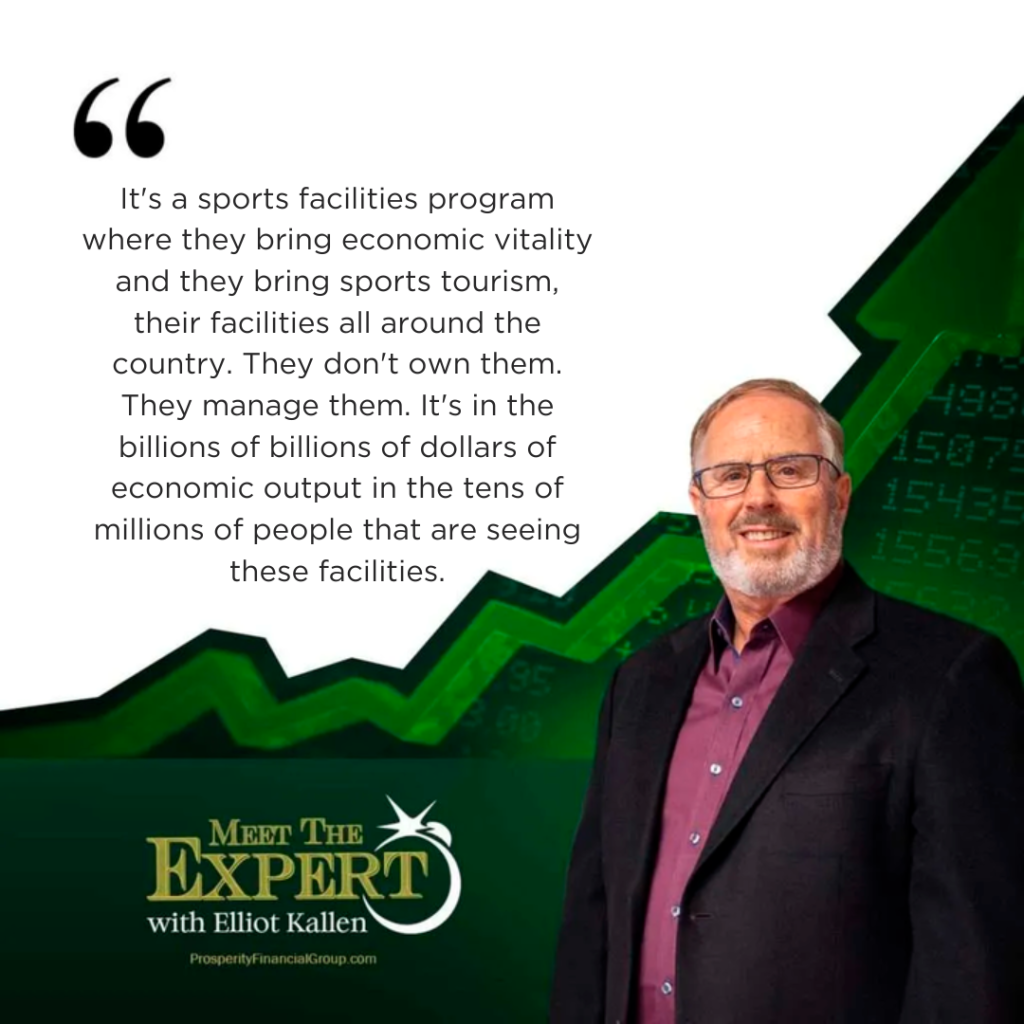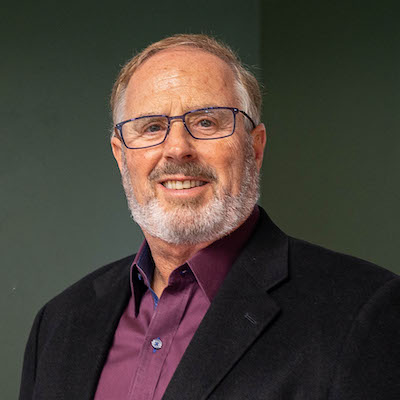The $14 Billion Sports Tourism Industry with Jason Clement
In this episode of “Meet the Expert with Elliot Kallen,” we dive into the niche world of sports facility management with Jason Clement, CEO of Sports Facilities Companies. Discover how Jason’s company builds and manages sports complexes that drive economic Growth and community engagement. We also explore the vital role sports play in youth development, the challenges kids face in competitive sports, and how these facilities can make a lasting impact. Tune in for valuable insights on entrepreneurship, economic vitality, and the balance between profit and purpose.
Watch the Episode Here
The Power of Sports Facility Management
Elliot: Good afternoon and good morning, everyone. I’m Elliot Kallen, CEO of Prosperity Financial Group. I’m so excited for this program—another track to keep you shaking in your boots and looking for new ideas in the marketplace. Today, we’re meeting with Jason Clement, CEO of Sports Facilities Companies out of the East Coast. Basically, what they do is build sports facilities for kids, adults, teens—whoever needs them. So, you might say, “Why are we interviewing him? What does that have to do with the financial planning world that we’re in?”
Meet Jason Clement
CEO of Sports Facilities Companies
We’re doing this because we’re bringing it to a business owner level. So many of our clients own companies and look to other entrepreneurs for ideas, and today is that opportunity to see what Jason has done, how he’s done it, and how finding a niche in a market can be a game-changer. Most of us think of sports facilities as being built by the town or by a developer, but today we’re going to hear a different story about how it works. So, without further ado, welcome to the show, Jason! Welcome to Meet the Expert with Elliot Kallen.
Jason: Elliot, great to be with you. Thanks for having me, and congratulations on the platform you’ve built here. It’s a real honor to be on with you.
Elliot: Jason, I want to start by asking, in a nutshell, what exactly do you do?
Jason: We help people strategically plan, Finance, fund, develop, and then manage youth and amateur sports complexes, as well as sports and Entertainment complexes.
Elliot: So, my initial thought is that towns handle this—the city of Fremont, the city of San Jose, the city where you are in Tampa, Florida. They don’t need you; they just bid it out, get the lowest bid for three fields, and think that’s all they need. So, why do they need you? What do you do differently?
Towns Need Expertise Beyond Just Building Facilities
Jason: Look, government is good at a number of things, but managing and optimizing these assets isn’t necessarily one of them. I’m not saying they’re all bad, but like a lot of industries, we’ve found our niche in helping them optimize the results they’re looking to accomplish, whether it’s a municipal government or private mixed-use developments. In today’s Economy, private-public partnerships are really the future.
A lot of these mixed-use developers are looking for incentives from municipalities, and they’re using these youth and amateur sports complexes as the anchor tenant, if you will—the draw that catalyzes the rest of the development and brings hundreds of thousands of visitors to the community. They can then leverage that for the rest of their development.
Elliot: Okay, so we’re talking about soccer—obviously, the number one sport for youth—football, baseball?
Flexible Sports Complex Design to Max Revenue
Jason: Yes, exactly. When we design and develop these complexes, we aim for flexible spaces. A soccer field can double as a football field, a rugby field, or a lacrosse field. We can also set up cross-field play to maximize the number of kids and families involved. Beyond sports, we also host band and performing arts competitions, concerts, and different types of events on those fields.
Then, you’ve got your diamond sports like baseball and softball. Cricket is also growing, especially after the World Cup Cricket held here in New York City. On the indoor side, we have basketball courts, volleyball courts, Pickleball—which is blowing up—and even non-sport activities like trade shows and conferences. These complexes really become mini-convention centers with flexible programming to serve as many people as possible.

Elliot: And what about basketball and ice hockey?
Jason: We do ice as well. We have ice rinks, seasonal aquatic centers, amphitheaters, RV parks, zip lines, ropes courses, and other amenities. Our vision is to develop and manage the highest-performing venues in the country, with the mantra to “serve more and serve better.” We want families to leave these complexes feeling really good about the experience they just had.
Elliot: That sounds impressive. Before we get into the financial side of this, because after all, this is a Money show, I want to ask how many people roughly visit these sports facilities annually, and are you maintaining control or management of these venues? How do you get paid from them?
Managing and Monetizing Sports Complexes Across the U.S.
Jason: We manage these complexes under five- to ten-year management agreements, typically with a blend of a fixed fee plus incentives based on the goals of the venue owner. We rarely take an ownership stake; it’s just not how we’ve decided to grow. Instead, we’ve focused on being an outsourced management provider, which allows us to grow faster. Across the venues we manage, we see about $500 million in visitor spending annually and around 40 million guest visits each year in the communities we serve.
Elliot: That’s incredible. Just to clarify, Jason Clement of Sports Facilities Companies builds and manages sports facilities all across the United States, based in Florida, and sees 40 million people—adults and children—visiting the facilities you manage each year. Is that right?
Jason: That’s right.
Elliot: And what does that translate to in terms of revenue for you?
Jason: It translates to about $200 million in revenue across the venues we’re involved with. That revenue comes from leagues, camps, clinics, tournaments, events, food and beverage sales, sponsorships, marketing partnerships, and other services that we manage and deliver on behalf of our clients and venue owners.
Elliot: How many employees does it take to manage all these facilities?
Jason: We started in 2003 with just three people. Today, we’ve grown to 3,300 employees.
Elliot: Wow, that’s some serious growth! And I assume you need to have people on the ground locally; you can’t manage a facility in Atlanta from Tampa.
The Economic Impact of Sports Facilities on Local Communities
Jason: Exactly. You need boots on the ground to ensure everything runs smoothly. Sports are so important—whether it’s for kids or adults, the quality of these facilities can make or break the experience. We need to be there to maintain that quality and ensure safety.
Elliot: Absolutely. As someone who played sports my whole life and watched my kids play competitively, I know how crucial good facilities are. I’ve seen poor conditions lead to injuries, like a kid breaking an ankle on a bad soccer field or getting hurt on rough ice. That’s something you want to avoid at all costs.

Jason: Definitely. Many existing complexes aren’t in pristine condition—let’s put it that way. Given the rising interest rates and the cost of construction, we’re seeing just as many opportunities to renovate and upgrade these existing complexes as there are to build new ones. Communities everywhere are looking at their recreation assets and asking how they can improve them to take advantage of the booming Travel sports economy. It’s a $14 billion industry right now, and whether they’re renovating or building new, municipalities want to maximize their share of that pie.
The Challenges Kids Face in Competitive Sports
Elliot: All these sports programs and facilities are increasing youth involvement, which is fantastic. But there’s another side to this—the kids who don’t play or who face challenges in sports. Not every kid is a star athlete, and some face tough moments, like making a mistake that costs their team the game. That can be really hard on them. How do you address the downside of sports?
Jason:
There was a study that asked kids about their favorite and least favorite parts of playing sports. The number one answer for the least favorite part was the car ride home. That’s because parents often use that time to critique their kids’ performance—telling them what they did wrong, what they could have done better. I’ve experienced that with my own kids, and it’s important to recognize that the ride home shouldn’t be about rehashing the game; it should be a time to decompress and enjoy a post-game treat or activity, like your mom did with White Castle.
To your mom’s credit, she made that after-game experience something special, regardless of the outcome. She made sure you and your brother felt grounded and could move past whatever happened on the field. That’s a great example of how parents can support their kids in sports without adding extra pressure.
And you’re right, kids grow more from their losses than their wins. It’s in those moments—when they strike out or drop the ball—that they learn resilience and how to handle adversity. But it’s also crucial how we, as parents and coaches, help them process those moments. That’s where character development comes into play, and it’s one of the most valuable lessons sports can offer.
GET IN TOUCH
Schedule a Visit
Elliot: That’s a powerful point, Jason. And speaking of character development, not all kids get the chance to play. There are many who don’t have access to sports due to financial constraints or other barriers. How does your company address this issue?
Jason: That’s an important issue, and it’s something we’re very conscious of. We believe that every child who wants to play sports should have the opportunity to do so, regardless of their financial situation. We advocate for programs that support underprivileged kids, ensuring that those who qualify for free or reduced lunch at school can also participate in free or reduced sports programs. Our mantra is, “If a kid is on free and reduced lunch, they should be on free and reduced play.” We work with local governments and organizations to create opportunities for these kids, so they aren’t left out of the sports experience.
We’re also seeing more involvement from large corporations and organizations that recognize the value of sports in youth development. They’re stepping up to support initiatives that make sports more accessible to all kids, not just those whose families can afford it.
Economic Benefits Versus a Skeptical Community
Elliot: That’s really commendable. I want to shift gears for a moment and talk about the economic impact of these sports facilities on local communities. When you’re pitching a new facility, how do you present the economic benefits to a community that might be skeptical about the value of such an investment?
Jason: That’s a great question, Elliot. The economic vitality that our facilities bring to local communities is significant, but it’s not always immediately obvious to everyone. When we pitch a new facility, we highlight not just the direct revenue it generates through sports events, but also the broader economic impact. This includes increased hotel occupancy, dining at local restaurants, Retail sales, and even property values.

For example, when a community hosts a large sports tournament, it draws in hundreds or even thousands of families who spend money on lodging, food, and entertainment. This influx of visitors creates a ripple effect throughout the local economy, boosting sales tax revenue and supporting local businesses. Additionally, a high-quality sports facility can become a central hub for community activity, enhancing the quality of life and making the area more attractive to new residents and businesses.
However, it’s important to acknowledge that not every type of facility will have the same impact. Take ice hockey, for example. While it’s a beloved sport, it’s tough to justify the high cost of building and maintaining ice rinks in areas where the Real Estate is expensive and the number of participants is relatively small. In these cases, we look for ways to integrate the facility into a larger mixed-use development that can offer more diverse revenue streams, such as fitness centers, retail spaces, or entertainment venues.
Elliot: So, you’re saying that it’s not just about the sports facility itself, but about creating a comprehensive development that serves multiple purposes and drives continuous economic growth.
The Sports Complex Ecosystem Extends Beyond Walls
Jason: Exactly. A sports facility can be the anchor that draws people in, but to truly maximize the economic impact, it needs to be part of a larger ecosystem. For example, we’re currently working on a development in Overland Park, Kansas, that includes not just sports fields and courts, but also fitness centers, restaurants, entertainment options like a Dave & Buster’s, and even a Topgolf-style attraction. By combining sports with entertainment, dining, and retail, we create a destination that appeals to a broader audience and keeps people coming back, which in turn supports the local economy.
Balancing Profit and Purpose in Sports Facilities
Elliot: That sounds like a winning formula. Now, before we wrap up, I want to touch on something you mentioned earlier—the pressure that kids face in sports, especially those who aren’t the stars of the team or who have a tough time handling losses. What advice would you give to parents and coaches to help kids navigate these challenges?
Jason: My advice would be to focus on the process, not just the outcome. Sports are about more than winning or losing—they’re about developing skills, building character, and learning how to work as part of a team. As parents and coaches, it’s our job to reinforce these values and help kids understand that their worth isn’t tied to their performance on the field.
One of the best things parents can do is make the post-game experience positive, regardless of the outcome. Whether it’s going out for ice cream, like your mom did, or just talking about something unrelated to the game, it’s important to help kids decompress and keep things in perspective. Coaches, on the other hand, should focus on teaching resilience and helping kids learn from their mistakes in a constructive way. Mistakes are inevitable, but they’re also opportunities for growth.
How Sports Facilities Can Support All Youth, Not Just Athletes
We also need to be mindful of the kids who don’t get to play. There’s a growing divide between those who can afford to participate in travel sports and those who can’t. It’s up to us as a community to find ways to include all kids, whether through scholarship programs, partnerships with local businesses, or other creative solutions. Every kid deserves the chance to experience the benefits of sports, and it’s our responsibility to make that happen.
Elliot: That’s such an important message, Jason. Sports have the power to shape kids’ lives in profound ways, but only if we approach it with the right mindset. I’m so glad we had this conversation today.
Jason: Thanks, Elliot. It’s been a pleasure, and I hope this discussion helps more people see the value of Investing in sports facilities and supporting all kids in their athletic journeys.
Important Links
- A Brighter Day Charity
- Resources for Parents and Teens
- Parenting a Teen Athlete
- Sports Facilities Companies
The post The $14 Billion Sports Tourism Industry with Jason Clement appeared first on Prosperity Financial Group | San Ramon, CA.























